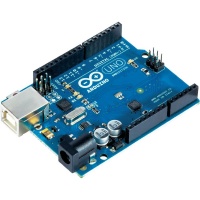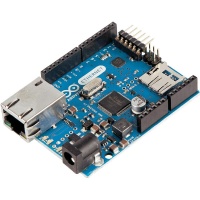Difference between revisions of "Arduino"
| Line 1: | Line 1: | ||
Arduino is a microcontroller platform and development tools combined into an easy-to-use, standardized and inexpensive architecture that can greatly enhance the physical input/output capabilities of HSYCO. | Arduino is a microcontroller platform and development tools combined into an easy-to-use, standardized and inexpensive architecture that can greatly enhance the physical input/output capabilities of HSYCO. | ||
| − | [[File: | + | [[File:Arduino_UNO.jpg|200px|thumb|Arduino UNO]] |
| + | [[File:Arduino_Ethernet.jpg|200px|thumb|Arduino Ethernet]] | ||
HSYCO supports Arduino through an open source library installed in the Arduino IDE. This library implements a bidirectional communication protocol with HSYCO. A sketch in Arduino that allows HSYCO to directly read and control any of the digital and analog pins on any Arduino board is only a few lines long, and is provided as a built-in example in the HSYCO library. | HSYCO supports Arduino through an open source library installed in the Arduino IDE. This library implements a bidirectional communication protocol with HSYCO. A sketch in Arduino that allows HSYCO to directly read and control any of the digital and analog pins on any Arduino board is only a few lines long, and is provided as a built-in example in the HSYCO library. | ||
HSYCO supports Arduino Uno, Arduino Ethernet, Arduino Due and other compatible boards. The connection is serial, usually over the USB port, or TCP over the Ethernet. | HSYCO supports Arduino Uno, Arduino Ethernet, Arduino Due and other compatible boards. The connection is serial, usually over the USB port, or TCP over the Ethernet. | ||
The Arduino I/O Server provides for datapoints to be used in the EVENTS language and Java to read and control Arduino pins, but also to exchange custom messages between your sketch in Arduino and HSYCO applications. | The Arduino I/O Server provides for datapoints to be used in the EVENTS language and Java to read and control Arduino pins, but also to exchange custom messages between your sketch in Arduino and HSYCO applications. | ||
| + | |||
| + | == Communication == | ||
| + | |||
| + | Arduino can be connected to HSYCO through a USB cable (serial communication) or via Ethernet depending on the model. | ||
| + | |||
| + | === Serial (USB) === | ||
| + | |||
| + | The comm port ID depends on your HSYCO server configuration. It should be "ttyACM0" if there are no other devices connected to the USB ports. | ||
| + | |||
| + | These are the default serial communication parameters used by the HSYCO library: | ||
| + | |||
| + | {| class="wikitable" | ||
| + | | '''Baud rate''' | ||
| + | | 115200 | ||
| + | |- | ||
| + | | '''Data bits''' | ||
| + | | 8 | ||
| + | |- | ||
| + | | '''Stop bit''' | ||
| + | | 1 | ||
| + | |- | ||
| + | | '''Parity''' | ||
| + | | none | ||
| + | |- | ||
| + | | '''Flow control''' | ||
| + | | none | ||
| + | |} | ||
| + | |||
| + | === Ethernet === | ||
| + | |||
| + | The IP address of the board is specified in it's sketch (see [[#Arduino Configuration]]) and the default port is 23. | ||
| + | |||
| + | == Arduino IDE Configuration == | ||
| + | |||
| + | == Arduino Configuration == | ||
Revision as of 11:26, 9 January 2014
Arduino is a microcontroller platform and development tools combined into an easy-to-use, standardized and inexpensive architecture that can greatly enhance the physical input/output capabilities of HSYCO.
HSYCO supports Arduino through an open source library installed in the Arduino IDE. This library implements a bidirectional communication protocol with HSYCO. A sketch in Arduino that allows HSYCO to directly read and control any of the digital and analog pins on any Arduino board is only a few lines long, and is provided as a built-in example in the HSYCO library. HSYCO supports Arduino Uno, Arduino Ethernet, Arduino Due and other compatible boards. The connection is serial, usually over the USB port, or TCP over the Ethernet. The Arduino I/O Server provides for datapoints to be used in the EVENTS language and Java to read and control Arduino pins, but also to exchange custom messages between your sketch in Arduino and HSYCO applications.
Contents
Communication
Arduino can be connected to HSYCO through a USB cable (serial communication) or via Ethernet depending on the model.
Serial (USB)
The comm port ID depends on your HSYCO server configuration. It should be "ttyACM0" if there are no other devices connected to the USB ports.
These are the default serial communication parameters used by the HSYCO library:
| Baud rate | 115200 |
| Data bits | 8 |
| Stop bit | 1 |
| Parity | none |
| Flow control | none |
Ethernet
The IP address of the board is specified in it's sketch (see #Arduino Configuration) and the default port is 23.

